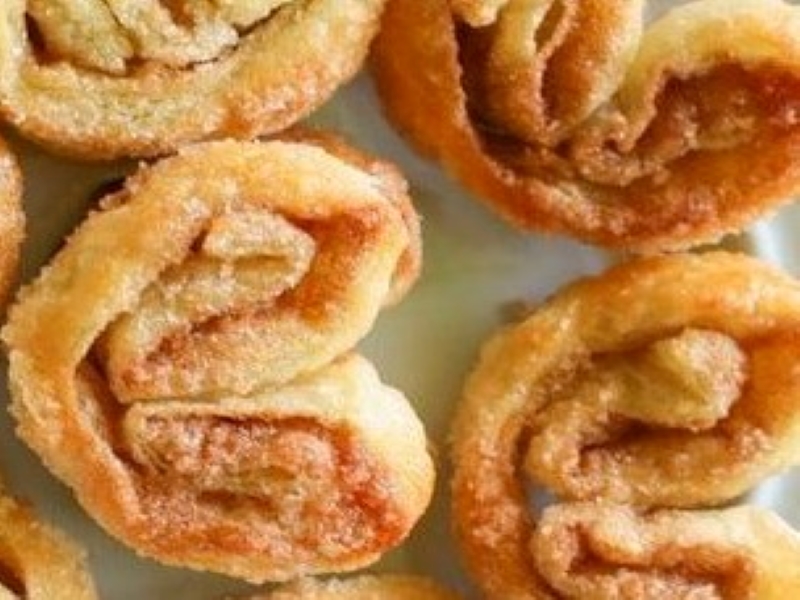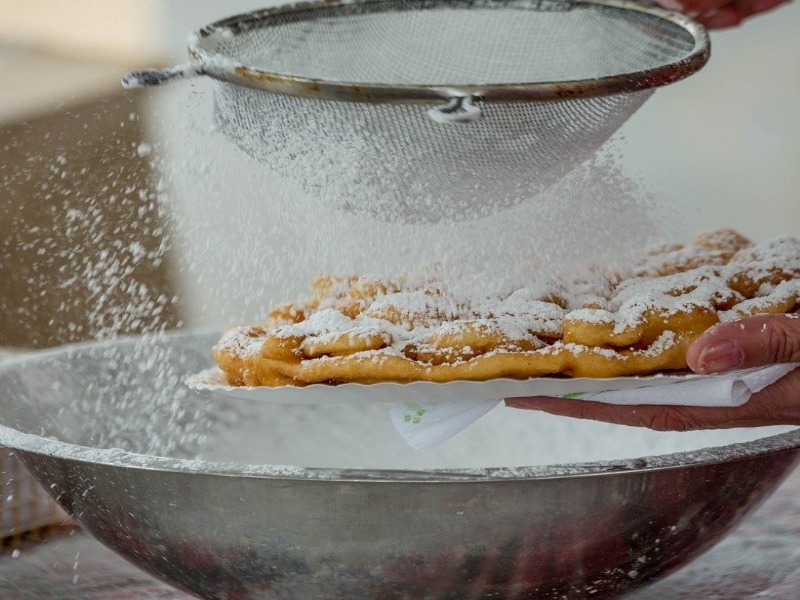Are you craving for delicious treats at county fairs? The foods that can only be found at a county fair or state fair are the finest things about them. We usually link fried dough treats, such as elephant ears and funnel cakes with county fairs, food trucks, carnivals, and theme parks, since these are the places where we enjoy fried dough treats. They taste delicious when consumed right away, after they are made. Despite the fact that they are made with the same dough and frying method, the manner they are created is different.
So what is the difference between an elephant ear and a funnel cake? Let’s find out below.
Elephant Ear vs Funnel Cake

What Is An Elephant Ear?
Elephant ear, also known as fried dough, fried bread, scones, palmiers and pizza fritte, is a flattened, deep fried dough. This fried food originated in America.
Elephant ears got their name from its huge, elephant ear-like form, which was based on the fry bread of Native Americans.
Fry bread was first created by the Navajo tribe in the southwestern United States in 1864. Flour, lard, sugar and salt donated by the US government were used by them to make fry bread. Navajo fry bread can be sweet, powdered sugar, or savory, with a toppings such as cheese or chili con carne.
Elephant ear is a sweet pastry dough, produced by rolling the dough out thin and flat, almost like a pizza. The dough is then re-rolled, cut into 2-3 inch pieces, and then flattened once more. The ultimate result resembles a cinnamon roll with a flat surface. This sweet treat is wrapped in cinnamon and sugar.
Elephant ears are the best option if you’re seeking for something to eat while on the go.

How To Make Elephant Ears
Ingredients:
- 6 tablespoons butter/margarine/shortening
- 1 teaspoon of salt
- 2 tablespoons of sugar
- 2 tablespoons of active dry yeast
- 4 cups flour (all-purpose)
- 1-1/2 cups of milk
- 3 to 4 cups vegetable oil for frying
- Cinnamon sugar
Instructions:
- In a frying pan, warm 1-1/2 cup milk on medium heat. You don’t want the milk to bubble or scald, so simply warm it up slightly before adding the rest of the ingredients.
- The liquid should be smooth. Remove the pan from the heat once there are no more chunks of shortening left. You have the option to slice the butter into tiny pieces before adding it to melt the shortening faster.
- Then, set the mixture aside to cool until it’s not too hot. It should be warm to touch, but not too hot. It should be roughly 110?. This promotes yeast growth without killing it. Keep in mind that if it’s too hot for you, it’s too hot for the yeast as well.
- As the yeast grows and produces carbon dioxide, the top will foam and froth. If there is no bubbles or frothing, it is an indication that the yeast has died, and you will have to start over again.
- Gently add 4 cups of flour and stir in into a yeast dough. One cup at a time, add the flour and mix the batter with a wooden ladle, dough hook, or your hands until it is a nice, firm dough ball.
- Knead the dough until it has a spongy, smooth texture. Although kneading may appear complicated, it is essentially a method of mixing the ingredients and toughening up the dough for cooking. Pull one side of the dough ball up, fold it onto the top of the dough ball, and then use the heel of your hand to push down into the fold. Turn the dough a quarter turn either direction, pull up another side, press with your hand, and repeat. You should knead for about 2 to 3 minutes. Once done, your dough should be spongy but consistent, holding its shape without being too tough to press
- Cover the dough and allow 30 minutes for the dough to rise. Then, place the dough in a metal, nonstick bowl. Use a moist cloth or a piece of plastic wrap to cover the top and put the dough in a warm, dry place for 30 minutes. This enables the yeast to perform their functions. When you’re through, the dough should be about twice as big as it is now.
- Cut the dough into equal sections. The larger you want your ears, the larger the dough will have to be. Start with four equal sections of dough and cut them into four even pieces in the center using a sharp knife.
- Using a rolling pin, flatten the pieces individually on a lightly floured surface. Make a quarter inch thick “ears” so that they fry quickly and evenly. If you want, you can stretch them into elephant ear shapes with your hands, but try to keep them all the way through at the same thickness. Add a pinch of flour to the pin and the countertop before you start to keep the ears from sticking.
- In a large deep frying pan, heat up oil to 365?. The oil has to be hot enough to cook the outsides of the elephant ear quickly, but not so hot that the outsides burn before the insides are cooked.
- Slowly cook both sides of the ears for 1-2 minutes a piece. The outside should be golden brown and the inside is flaky.
- Next, remove from the hot oil and pat it dry with paper towel. Drop the elephant ear onto a plate to drain any excess oil, then flip it when it is cool enough to touch.
- Lastly, sprinkle the tops with cinnamon sugar. Optional sweet toppings are powdered sugar, fresh fruit, jam or jelly. For best result, serve warm.

What Is A Funnel Cake?
Another tasty dessert that you can eat at carnivals , county fairs and amusement parks is Funnel cake.
The funnel cake originated in the early medieval Persian and Arab worlds as Zalabiyeh, when similar yeast-risen foods were first made, and then spread to Europe. The yeast dish, known as Drechderkuche, was brought to America by Dutch immigrants from Pennsylvania, and around 1879, the baking powder variation, known as funnel cake, was produced. A funnel cake is often sprinkled with powdered sugar.
Funnel cakes are created by pouring batter into hot oil in a circular pattern and deep frying it until light brown or golden brown. A funnel is typically used to pour the batter (hence the name, funnel cakes) . You can then make long stringy dough lines by carefully squeezing it out.
Despite the fact that funnel cakes are more photogenic than elephant ears, they are the messier of the two. If you don’t mind messy eating, then funnel cakes can be a good choice for you. Every food blogger will enjoy their shape because it gives them an advantage in terms of food aesthetic photography.

How To Make Funnel Cake
Ingredients
- 2 cups flour
- 2 eggs
- 1 teaspoon vanilla
- 1 teaspoon baking powder
- 1 cup milk
- 2 tablespoons sugar
- ¼ teaspoon salt
- 1/2 teaspoon cinnamon
- 3/4 cup powdered sugar
- vegetable oil
Instructions
- Whisk together the milk, eggs, and vanilla in a large mixing bowl.
- Then, combine the flour, baking powder, sugar, salt, cinnamon and sugar in a separate mixing bowl.
- Add the dry ingredients to the wet ingredients. Whisk them until the mixture is blended and smooth.
- Heat oil to 375° degrees in a medium sized pan. Using a measuring cup with a spout, fill it with the funnel cake batter.
- Gently drizzle about 1/2 cup of the mixture into the hot vegetable oil a circular motion and then crisscrossing to link them. Cook for less than 2 minutes or until brown on the bottom. Flip and cook the other side.
- Remove from the hot oil and pat it dry with paper towel. You can sprinkle it with powdered sugar or your favorite toppings. Serve warm for best results.

